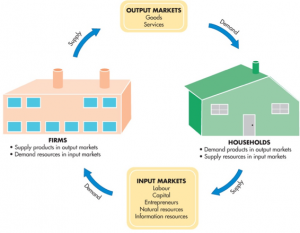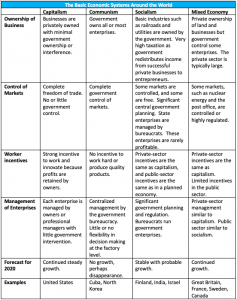1.2 Economic Systems Around the World
What is Economics?
To appreciate how a business functions, we need to know something about the economic environment in which it operates. We begin with a definition of economics and a discussion of the resources used to produce goods and services.
Resources: Inputs and Outputs
Economics is the study of how individuals, businesses, governments and nations allocate their limited resources to satisfy their unlimited wants and needs. The allocation of resources is concerned with the production, distribution, and consumption of goods and services. Resources are the inputs used to produce outputs. Resources may include any or all of the following and their connections with one another:
- Land and other natural resources
- Labour (physical and mental)
- Capital, including buildings and equipment
- Entrepreneurship
- Knowledge
Resources are combined to produce goods and services. Land and natural resources provide the needed raw materials. Labour transforms raw materials into goods and services. Capital (equipment, buildings, vehicles, cash, and so forth) are needed for the production process. Entrepreneurship provides the skill, drive and creativity needed to bring the other resources together to produce a good or service to be sold to the marketplace.
Because a business uses resources to produce things, we also call these resources factors of production. The factors of production used to produce a shirt would include the following:
- The land that the shirt factory sits on, the electricity used to run the plant, and the raw cotton from which the shirts are made
- The labourers who make the shirts
- The factory and equipment used in the manufacturing process, as well as the money needed to operate the factory
- The entrepreneurship skills and production knowledge used to coordinate the other resources to make the shirts and distribute them to the marketplace
Input and Output Markets
Many of the factors of production are provided to businesses by households. For example, households provide businesses with labour (as workers), land and buildings (as landlords), and capital (as investors). In turn, businesses pay households for these resources by providing them with income, such as wages, rent, and interest. The resources obtained from households are then used by businesses to produce goods and services, which are sold to provide businesses with revenue. The revenue obtained by businesses is then used to buy additional resources, and the cycle continues. This is described in the figure below, “The Circular Flow of Inputs and Outputs”, which illustrates the dual roles of households and businesses:
- Households not only provide factors of production (or resources) but also consume goods and services
- Businesses not only buy resources but also produce and sell both goods and services

Economic Systems
Businesses and other organizations operate according to the economic systems of their home countries. Today the world’s major economic systems fall into two broad categories: free market, or capitalism; and planned economies, which include communism and socialism. However, in reality many countries use a mixed market system that incorporates elements from more than one economic system. The major differentiator among economic systems is whether the government or individuals decide:
- How to allocate limited resources—the factors of production—to individuals and organizations to best satisfy unlimited societal needs
- What goods and services to produce and in what quantities
- How and by whom these goods and services are produced
- How to distribute goods and services to consumers
Managers must understand and adapt to the economic system or systems in which they operate. Companies that do business internationally may discover that they must make changes in production and selling methods to accommodate the economic system of other countries. Table 1.1 summarizes key factors of the world’s economic systems.

Capitalism
In recent years, more countries have shifted toward free-market economic systems and away from planned economies. Sometimes, as was the case of the former East Germany, the transition to capitalism was painful but fairly quick. In other countries, such as Russia, the movement has been characterized by false starts and backsliding. Capitalism, also known as the private enterprise system, is based on competition in the marketplace and private ownership of the factors of production (resources). In a competitive economic system, a large number of people and businesses buy and sell products freely in the marketplace. In pure capitalism, all the factors of production are owned privately, and the government does not try to set prices or coordinate economic activity.
A capitalist system guarantees certain economic rights: the right to own property, the right to make a profit, the right to make free choices, and the right to compete. The right to own property is central to capitalism. The main incentive in this system is profit, which encourages entrepreneurship. Profit is also necessary for producing goods and services, building manufacturing plants, paying dividends and taxes, and creating jobs. The freedom to choose whether to become an entrepreneur or to work for someone else means that people have the right to decide what they want to do on the basis of their own drive, interest, and training. The government does not create job quotas for each industry or give people tests to determine what they will do.
Competition is good for both businesses and consumers in a capitalist system. It leads to better and more diverse products, keeps prices stable, and increases the efficiency of producers. Companies try to produce their goods and services at the lowest possible cost and sell them at the highest possible price. But when profits are high, more businesses enter the market to seek a share of those profits. The resulting competition among companies tends to lower prices. Companies must then find new ways of operating more efficiently if they are to keep making a profit—and stay in business.
Communism
The complete opposite of capitalism is communism. In a communist economic system, the government owns virtually all resources and controls all markets. Economic decision-making is centralized: the government, rather than the competitive forces in the marketplace, decides what will be produced, where it will be produced, how much will be produced, where the raw materials and supplies will come from, who will get the output, and what the prices will be. This form of centralized economic system offers little if any choice to a country’s citizens. Early in the 20th century, countries that chose communism, such as the former Soviet Union and China, believed that it would raise their standard of living. In practice, however, the tight controls over most aspects of people’s lives, such as what careers they can choose, where they can work, and what they can buy, led to lower productivity. Workers had no reasons to work harder or produce quality goods, because there were no rewards for excellence. Errors in planning and resource allocation led to shortages of even basic items.
These factors were among the reasons for the 1991 collapse of the Soviet Union into multiple independent nations. Recent reforms in Russia, China, and most of the eastern European nations have moved these economies toward more capitalistic, market-oriented systems. North Korea and Cuba are the best remaining examples of communist economic systems. Time will tell whether Cuba takes small steps toward a market economy now that the United States re-established diplomatic relations with the island country a few years ago.
Socialism
Socialism is an economic system in which the basic industries are owned by the government or by the private sector under strong government control. A socialist state controls critical, large-scale industries such as transportation, communications, and utilities. Smaller businesses and those considered less critical, such as retail, may be privately owned. To varying degrees, the state also determines the goals of businesses, the prices and selection of goods, and the rights of workers. Socialist countries typically provide their citizens with a higher level of services, such as health care and unemployment benefits, than do most capitalist countries. As a result, taxes and unemployment may also be higher in socialist countries. For example, in 2017, the top individual tax rate in France was 45 percent, compared to 39.6 percent in the United States. With both countries electing new presidents in 2017, tax cuts were a campaign promise that both President Macron and President Trump took on as part of their overall economic agendas for the coming years.
Many countries, including the United Kingdom, Denmark, India, and Israel, have socialist systems, but the systems vary from country to country. In Denmark, for example, most businesses are privately owned and operated, but two-thirds of the population is sustained by the state through government welfare programs.
Mixed Economic Systems
Pure capitalism and communism are extremes; real-world economies fall somewhere between the two. The U.S. economy leans toward pure capitalism, but it uses government policies to promote economic stability and growth. Also, through policies and laws, the government transfers money to the poor, the unemployed, and the elderly or disabled. American capitalism has produced some very powerful organizations in the form of large corporations, such as General Motors and Microsoft. To protect smaller firms and entrepreneurs, the government has passed legislation that requires that the giants compete fairly against weaker competitors.
Canada, Sweden, and the UK, among others, are also called mixed economies; that is, they use more than one economic system. Sometimes, the government is basically socialist and owns basic industries. In Canada, for example, the government owns the communications, transportation, and utilities industries, as well as some of the natural-resource industries. It also provides health care to its citizens. But most other activity is carried on by private enterprise, as in a capitalist system. In 2016, UK citizens voted for Britain to leave the European Union, which took years to finalize. The Brexit decision impacted the UK economy in many ways, increasing its autonomy while creating trade barriers between the UK and the EU (Berg, 2024).
The few factors of production owned by the government in a mixed economy include some public lands, the postal service, and some water resources. But the government is extensively involved in the economic system through taxing, spending, and welfare activities. The economy is also mixed in the sense that the country tries to achieve many social goals—income redistribution and retirement pensions, for example—that may not be attempted in purely capitalist systems.
Source: “Weighed Down by Gravity: UK Trade Policy after Brexit,” https://www.cer.eu/insights/weighed-down-gravity-uk-trade-policy-after-brexit#:~:text=Similarly%2C%20there%20are%20restrictions%20on,to%20qualify%20for%20FTA%20preferences, accessed June 23, 2024.

